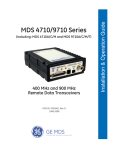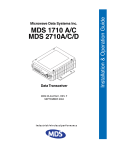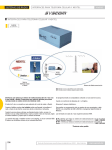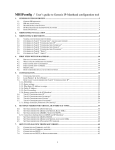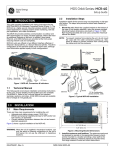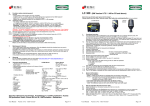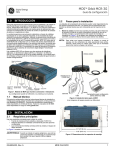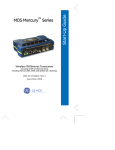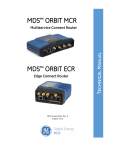Download MDS TransNET 900 Troubleshooting guide
Transcript
MDS TransNET Publication No. 05-4481A01, Rev. A 1.0 INTRODUCTION The transceiver, shown in Figure 1, is a spread spectrum radio designed for license-free operation. These units employ Digital Signal Processing (DSP) technology to provide highly-reliable long-distance communications, even in the presence of weak signals or interference. The transceiver is housed in a compact and rugged die-cast enclosure that need only be protected from direct exposure to the weather. It contains a single printed circuit board with all necessary components for radio operation. No jumper settings or manual adjustments are required to configure the radio for operation. In addition to these instructions, the MDS TransNET Reference Manual (05-2708A01) provides helpful guidance on TransNET systems. Electronic copies of all user documents and data sheets are available free of charge at www.GEmds.com. 1.2 Typical Applications 1.2.1 Multiple Address Systems (MAS) This is the most common application of the transceiver. It consists of a central control station (Master) and two or more associated Remote units, as shown in Figure 2. An MAS network provides communications between a central host computer and remote terminal units (RTUs) or other data collection devices. The operation of the radio system is transparent to the computer equipment. When used in this application, the transceiver provides an excellent alternative to traditional (licensed) MAS radio systems. MDS TransNET Remote RTU RXD RTU MDS TransNET Remote TXD C SYN PWR RXD TXD C SYN 1.1 Transceiver Features PWR Listed below are several key features of the transceiver. These are designed to ease the installation and configuration of the radio, while retaining the ability to make changes in the future. • 902–928 MHz operation using the TransNET 900 • 2400–2482 MHz ISM band operation with the TransNET 2400 • User-selectable option to skip sub-bands with constant interference • 65,000 available network addresses • Network-wide configuration from the Master station eliminates most trips to Remote sites • Data transparency ensures compatibility with virtually all asynchronous SCADA system RTUs • Peak-hold RSSI averaged over eight hop cycles • Operation at up to 115,200 bps continuous data flow • Store-and-Forward repeater operation • Data latency typically less than 10 ms • Same hardware for Master or Remote configuration • Supports RS/EIA-232 and RS/EIA-485 user interface • Low current consumption; typically less than 3 mA in “sleep” mode MDS TransNET Remote RXD TXD C SYN RTU PWR MDS TransNET Master RXD RXD TXD TXD C SYN C SYN PWR RTU PWR MDS TransNET Remote Host System Figure 2. Typical MAS Network 1.2.2 Point-to-Point System A point-to-point configuration (Figure 3) is a simple arrangement consisting of just two radios—a Master and a Remote. This provides a half-duplex communications link for the transfer of data between two locations. Invisible place holder MDS TransNET Master MDS TransNET Remote Host System Figure 3. Typical Point-to-Point Link 1.2.3 Figure 1. MDS TransNET Series Transceiver NOTE: Some radio features may not be available on all models, or limited by the options purchased, or the applicable regulatory constraints for the region in which the radio will operate. 05-4481A01, Rev. A Adding a Tail-End Link to an Existing Network A tail-end link can be used to extend the range of a traditional (licensed) MAS system. This might be required if an outlying site is blocked from the MAS Master station by a natural or man-made obstruction. In this arrangement, a TransNET radio links the outlying Remote site into the rest of a licensed MAS system by sending data from that site to an associated TransNET installed at one of the licensed Remote sites (see Figure 4 on Page 2). As the data from the outlying site is received at the licensed Remote site, it is transferred to the licensed radio (via a local cable connection) and is then transmitted to the MAS Master station in GE MDS TransNET Quick Start Guide 1 The following steps provide an overview of the installation procedure. For additional details, refer to the MDS TransNET Reference Manual (05-2708A01). the usual manner. REPEATER STATION MDS x710B Series Radio Master Station MDS TransNET Master 1. Select a site that provides stable power, protection from the weather, entrances for antenna and other cabling, and an antenna location with an unobstructed transmission path in the direction of the associated station(s). SP RE TO AD OU SPE TL CT YI RU NG M SI LIN TE K PWR SYNC TXD RXD ACTIVE STBY ALARM RX ALR TX ALR ACTIVE LINE STBY ALARM RX ALR TX ALR LINE ENTER ESCAPE Null-Modem Cable 2. Select and install an appropriate antenna and feedline for your system requirements. MDS TransNET Remote Remote Radio SYNC TXD RXD OUTLYING REMOTE SITE RTU RTU RTU 3. Mount the transceiver to a stable surface using the brackets supplied with the radio (fasteners/anchors are not supplied). PWR Remote Radio LICENSE-FREE SPREAD SPECTRUM SYSTEM MAS SYSTEM (LICENSED OR UNLICENSED) Figure 4. Typical Tail-End Link Arrangement 1.2.4 Extending a TransNET Network with a Repeater Similar to a Tail-End Link, Store-and-Forward (SAF) offers a way to physically extend the network range, but in a simple and economical manner. SAF works by dividing a network into a vertical hierarchy of two or more sub-networks. Extension radios (designated as MODE X) serve as single-radio repeaters that link adjacent sub-networks, and move data from one sub-network to the next one. 4. Connect the data equipment to the transceiver’s DATA connector. Use only the required pins for the application. Refer to Figure 7. 5. Measure and install the primary power for the transceiver. It must be within 6–30 Vdc (including transients) and be capable of providing 7.5 watts over this voltage range. (Typical current draw is 400 mA @13.8 Vdc; 0.9 A at 6 Vdc.) A power connector with screw-terminals is provided with each unit. Invisible place holder REPEATER STATION SP MDS TransNET Master MODE = M SAF = ON RE TO AD OU SPE TL CT YI RU NG M SI LIN TE K RTU Antenna Data Primary Power (6–30 Vdc) Diagnostic (Payload) (Communications) MDS TransNET Extension MODE = X MDS TransNET Remote MODE = R Figure 7. Interface Connector Functions MDS TransNET Remote MODE = R RTU MDS TransNET Remote MODE = R OUTLYING REMOTE SITE RTU RTU Figure 5. TransNET Repeater Network 1.3 Accessories 7. Perform the initial start-up of the transceiver: GE MDS offers an Accessories Selection Guide listing additional items that may be used with our products. Contact your factory representative or visit www.GEmds.com for the latest copy. 2.0 2.1 6. Set the radio’s basic configuration with a PC terminal connected to the DIAG(nostics) connector via an RJ-11 to DB-9 adapter cable, MDS P/N 03-3246A01. For more information on connecting a PC terminal and preparing it for use, refer to the MDS TransNET Reference Manual (05-2708A01). Three essential settings for the transceiver are: • Mode: Master, Remote, or Extension • Network Address: A unique number from 1 to 65000 • Data Interface Parameters: bps, data bits, parity, stop bits a. Apply primary power. b. Observe the transceiver LED status panel for proper indications. HARDWARE INSTALLATION PWR TransNET Installation Figure 6 shows a typical Remote station arrangement. Master stations are similar, but an omni-directional antenna is normally used instead of a directional type, and a host computer replaces the data terminal equipment. DATA TERMINAL EQUIPMENT SYNC TXD RXD In a normally operating system, you will see the following indications within 16 seconds of start-up: ANTENNA SYSTEM PWR lamp lit continuously SYNC lamp lit continuously Remote radio(s) transmitting data (TXD) and receiving data (RXD) with the Master station. MDS Transceiver E N LI D SS E FE O POWER SUPPLY 13.8 VDC @ 500 mA (6–30 Vdc) -L W LO Figure 6. Typical Remote Station Arrangement 2 8. Optimize the installation by checking: • Antenna aiming • Antenna SWR • Data buffer setting (Modbus protocol) • Hoptime setting • TotalFlow™ Protocol at 9600 with Sleep Mode • Operation at 115200 bps • Baud rate setting GE MDS TransNET Quick Start Guide 05-4481A01, Rev. A • Radio interference checks For more information on how to perform these optimization steps, refer to the MDS TransNET Reference Manual (05-2708A01). 3.0 RADIO PROGRAMMING There are no manual adjustments on the radio. Programming and control is performed through a PC connected to the radio’s DIAG connector. Programming is performed by either establishing a terminal connection to the radio (by using a terminal emulator such as HyperTerminal), or by connecting to the radio using MDS TransNET Configuration Software (P/N 06-4059A01). For more information, refer to the MDS TransNET Reference Manual (05-2708A01). 3.1 User Commands The following tables provide brief descriptions of the various user commands for the transceiver. For more information, refer to the MDS TransNET Reference Manual (05-2708A01). Table 3: Operational Configuration COMMAND DESCRIPTION ADDR [1–65000] Program network address AMASK [0000 0000–FFFF FFFF] Alarm response ASENSE [HI/LO] Sense of the alarm output on Pin 6 of the DATA interface connector in the EIA-232 mode. Default: Alarm present = HI BAND [A, B, C] Selects one of three operating bands. (2.4 GHz Model Only) BAUD [xxxxx abc] Data communication parameters CODE [NONE, 1...255] Select the security/encryption setting in the radio CSADDR [1–65000] Used on a single Master/Remote network to support TDD-style simulated full-duplex. CTS [0–255] CTS delay in milliseconds (A value of 0 returns CTS immediately) CTSHOLD [0–60000] “Hold time” that CTS is present following last character from DATA port. DEVICE [DCE, CTS KEY] Device behavior: DCE (normal) or CTS Key MODE [M, R, X] Operating mode: M = Master, R = Remote, X = Extension MRSSI [NONE, -40...-90] Minimum RSSI level required to preserve synchronization with a Master radio for Remotes in mobile service. OT [ON, OFF] Enables a 1-second delay on delivery of RXD serial data. OWN [xxxxx] Owner’s name, or alternate message (30 characters maximum) PORT [RS232, RS485] Data port (DATA connector) interface signaling mode: RS232 or RS485 PWR [20–30] Power output in dBm RXD [0–255] Set RXD delay time for virtual seamless mode with low latency RXTOT [NONE, 0–1440] Maximum duration (in minutes) before time-out alarm. Default is OFF. RTU [ON, OFF, 0–80] Enable or Disable unit’s built-in RTU simulator. Default is OFF. Set RTU address between zero and 80. SLEEP [ON, OFF] Enable or Disable the radio’s energy-conservation Sleep mode function. UNIT [10000–60000] Unit address used for network-wide diagnostics. (Unique within associated network.) XADDR [0–31] This unit’s Extended address Table 1: Network Configuration—Master Station COMMAND DESCRIPTION AT [ON, OFF] Enables Master station to emulate a modem and respond to AT commands BUFF [ON, OFF] ON = Seamless data OFF = Fast byte throughput. FEC [ON, OFF] Sets/disables FEC (Forward Error Correction) setting. HOPTIME [7, 28] Displays hop-time or sets it to 7 or 28 ms. LPM [1, 0] Used at Master to set all associated stations in an energy-conservation mode. 1 = Low-power mode enabled network-wide 0 = Disable low-power mode (Default) REPEAT Sets/displays the fixed downstream re-send count. RETRY [0–10] Sets/displays the maximum upstream re-send count for ARQ (Automatic Repeat Request) operation SAF [ON, OFF] SKIP [NONE, 1...8] Enables/disables the store-and-forward function for the network controlled by this Master unit. Skip one or more frequency zones Table 2: Network-Wide Diagnostics COMMAND DESCRIPTION DLINK [xxxxx/ON/OFF] Controls operation of diagnostic link function. DTYPE [NODE/ROOT] Set radio’s operational characteristics for network-wide diagnostics Default: FFFF FFFF Typically, the Master is set to zero (0). 05-4481A01, Rev. A XMAP [00000000–FFFFFFFF] Included Extended units in MODE X. (Extensions and Remotes only) XPRI [0–31] Address of the primary Extended radio unit (Extension). GE MDS TransNET Quick Start Guide 3 Table 3: Operational Configuration (Continued) COMMAND DESCRIPTION COMMAND DESCRIPTION XRSSI [NONE, -40...-120] Minimum RSSI level required to preserve synchronization with a non-primary radio. (Only meaningful when XPRI is not NONE) SAF Store-and-forward mode status in this unit. (ON/OFF) SER Serial number of radio SHOW CON Display virtual modem connection status SHOW PWR RF output power. Measured RF power in dBm. ZONE CLEAR Reset zone data statistics Table 4: Operating Status—Display Only COMMAND DESCRIPTION SHOW SYNC Information on synchronization source ADDR Network address SKIP Frequency zones that are skipped AMASK Alarm mask (response) SLEEP ASENSE Current sense of the alarm output. Radio’s Sleep Mode setting. (At Remotes Only) BAUD Data communication parameters. Example: BAUD 9600 8N1 SREV Transceiver firmware revision level STAT Current alarm status TEMP Transceiver’s internal temperature (°C) UNIT Programmed unit address for network-wide diagnostics “NONE” (Inactive), or “ACTIVE” XADDR This unit’s Extended address CTS CTS delay in milliseconds (0–255 ms) XPRI CTSHOLD “Hold time” that CTS is present following last character from DATA port. Address of the primary Extended radio unit (Extension). XMAP DEVICE Device behavior Included Extended units in MODE X. (Extensions and Remotes only). XRSSI Minimum RSSI level required to preserve synchronization with a non-primary radio. (Only meaningful when XPRI is not NONE) BUFF Data buffering mode: ON = seamless data, OFF = fast byte throughput CODE Security/encryption operational status. Alternatives: DCE and CTS KEY HOPTIME Hop-time value in milliseconds (ms). LPMHOLD Time (0-1000 ms) provided to give an RTU time to respond before the radio goes to sleep. MODE MRSSI 4 Table 4: Operating Status—Display Only (Continued) Table 5: Diagnostic and Test Functions Current operating mode: COMMAND DESCRIPTION M = Master R = Remote X = Extension (Repeater) KEY Enables the transmitter test. (must be in Setup mode). DKEY Turns off the transmitter test (must be in Setup mode). TX [xxxx] Set/display transmit test frequency (must be in Setup mode). RX [xxxx] Set/display receive test frequency. (must be in Setup mode). SETUP Enables Setup mode. Times out after 10 minutes. Press “Q” to quit. Minimum RSSI level required to preserve synchronization with a Master radio for Remotes in mobile service. OWM Owner’s message or site name OT Status (ON/OFF) of the 1-second delay on delivery of RXD serial data. OWN Owner’s name or system name PORT Current data port (DATA connector) interface signaling mode: RS232 or RS485 ZONE DATA Zone data statistics PWR Forward power-output setting in dBm ZONE CLEAR Clears the Zone Data log REPEAT The fixed downstream re-send count. RETRY The maximum upstream re-send count for ARQ (Automatic Repeat Request) operation. RSSI Received signal strength indicator (in dBm). Unavailable at Master unless SETUP is enabled. RTU RTU simulator’s operational status (ON/OFF) RXTOT The amount of time (in seconds) to wait before issuing a time-out alarm. GE MDS TransNET Quick Start Guide 05-4481A01, Rev. A 4.0 If more than one alarm exists, the word MORE appears at the bottom of the screen; additional alarms can be viewed by pressing ENTER. TROUBLESHOOTING Successful troubleshooting of an MDS transceiver system is not difficult, but requires a logical approach. It is best to begin troubleshooting at the Master station, as the rest of the system depends on the Master for polling instructions and synchronization data. If the Master station has problems, the operation of the entire network will be affected. When communication problems are found, it is good practice to begin by checking the basics. All radios in the network must meet these basic requirements: • Adequate and stable primary power • An efficient and properly aligned antenna system • Secure connections (RF, data & power) • Proper programming of the radio’s operating parameters, especially Operating Mode (MODE), Network Address (ADDR), and interface Baud Rate (BAUD). For TransNET 2400 check the sub-band (BAND). • The correct interface between the radio and the connected data equipment (proper cable wiring, data format and timing). • In store-and-forward systems there are several areas that should be checked or evaluated: • Look for duplicate XADDR values on MODE M and MODE X radios. Duplicates will cause failures unless the radios are too far apart to hear each other. • Check for errors in the synchronization qualifiers, XPRI and XMAP, on corresponding Remote radios. • Verify SAF is enabled at the Master radio. 4.1 LEDs Table 6 describes how to use the LEDs as a troubleshooting aid whenever you suspect a problem with the transceiver. Table 7: Alarm Codes Alarm Code Alarm Type Description 00 Major The network address is not programmed. 01 Major Improper firmware detected for this radio model. 04 Major One or more of the programmable synthesizer loops is reporting an out-of-lock condition. 08 Major The system is reporting that it has not been calibrated. Factory calibration is required for proper radio operation. 10 Major The DSP was unable to properly program the system to the appropriate defaults. A hardware problem may exist. 12 Major Receiver time-out alarm. 16 Minor The unit address is not programmed. 17 Minor A data parity fault has been detected on the DATA connector. This usually indicates a parity setting mismatch between the radio and the RTU. 18 Minor A data framing error has been detected on the DATA connector. This may indicate a baud rate mismatch between the radio and the RTU. 29 Minor RF output power fault detected. (Power differs by more than 2 dB from set level.) Often caused by high antenna system SWR. Check antenna, feedline and connectors. 30 Minor The system is reporting an RSSI reading below –105 dBm. 31 Minor The transceiver’s internal temperature is approaching an out-of-tolerance condition. If the temperature drifts outside of the recommended operating range and the transceiver may fail. Table 6: LED Indicator Descriptions Name Description 4.2.2 PWR • Continuous—Power is applied to the radio; no problems detected Major alarms report serious conditions that generally indicate a hardware failure, or other abnormal condition that will prevent (or seriously hamper) further operation of the transceiver. With the exception of alarm code 00 (network address not programmed), major alarms generally indicate the need for factory repair. Contact MDS for further assistance. Minor alarms report conditions which, under most circumstances, will not prevent transceiver operation. This includes out-of-tolerance conditions, baud rate mismatches, etc. The cause of these alarms should be investigated and corrected to prevent system failure. • Flashing (5 times-per-second)—Fault indication. See Section 4.0, Troubleshooting. • Off—Radio is unpowered or in Sleep mode SYNC Continuous—Radio is receiving/sending synchronization frames On within 10 seconds of power-up under normal conditions TXD Transmit data activity on the DB-9 DATA interface connector RXD Receive data activity on the DB-9 DATA interface connector 4.2 Major Alarms versus Minor Alarms Alarm Codes When an alarm condition exists, the transceiver creates an alarm code. These codes can be very helpful in resolving many system difficulties. 4.2.1 Checking for Alarms—STAT command To check for the presence of alarms, enter STAT. If no alarms exist, the message NO ALARMS PRESENT appears at the top of the display. If an alarm does exist, a two-digit alarm code (00–31) is displayed, and it is identified as a major or minor alarm. A brief description of the alarm is also given. Alarm codes and their meanings are listed in Table 7. 05-4481A01, Rev. A GE MDS TransNET Quick Start Guide 5 4.3 Troubleshooting Chart Table 8 provides suggestions for resolving system difficulties that may be experienced in the radio system. If problems persist, contact the factory for further assistance. Table 8: Troubleshooting Guide Difficulty Recommended System Checks Unit is inoperative a.Check for the proper supply voltage at the power connector. b.The transceiver’s internal fuse may have opened. Interference is suspected a.Verify that the system has a unique network address. Nearby systems with the same address will cause interference. b.Check for interference by locking out affected zone(s) using the SKIP command. c. If omnidirectional antennas are used on Remote stations, consider changing to directional antennas. This will often limit interference to and from other stations. No synchronization with Master, or poor overall performance a.Check for secure interface connections at the radio and the connected device. b.Check the antenna, feedline and connectors. Reflected power should be less than 10% of the forward power reading (SWR ≈ 2:1 or lower). c. If the Remote radio is in synchronization, but performance is poor, check the received signal strength using the RSSI command. If RSSI is low, it may indicate antenna problems, or misalignment of directional antenna headings. 4.4 Technical Assistance Factory technical assistance is available by contacting GE MDS during business hours (8:30 AM to 6:00 PM Eastern Time). Use one of the following means to contact the factory: Telephone: (585) 241-5510 E-mail: [email protected] Web: www.GEmds.com FAX: (585) 242-8369 Part 15 Notice This Equipment has been tested and found to comply with the limits for a Class A digital device, pursuant to Part 15 of the FCC Rules. These limits are designed to provide reasonable protection against harmful interference when the equipment is operated in a commercial environment. This equipment generates, uses, and can radiate radio frequency energy and, if not installed and used in accordance with the instruction manual, may cause harmful interference to radio communications. Operation of this equipment in a residential area is likely to cause harmful interference in which case users will be required to correct the interference at their own expense. This device complies with Part 15 of the FCC Rules. Operation is subject to the following two conditions: (1) this device may not cause harmful interference, and (2) this device must accept any interference received; including interference that may cause undesired operation. Warning: Changes or modifications not expressly approved by the manufacturer could void the user’s authority to operate the equipment. d.Verify proper programming of system parameters: mode, network address, data interface baud rate, transmitter power, CTS delay, etc. For store-and-forward applications, also verify the following: SAF is ON; extended address is properly programmed at each extension; Remotes are using the proper values for XPRI and XMAP. e.Check for alarms using the STAT command. BER is too high. Data throughput is spotty a.The RETRY and REPEAT commands may be increased to deal with interference, or decreased to increase throughput and reduce latency. b.Try turning on FEC. FEC on gives some coding gain, but comes at the cost of reduced throughput. Latency is too high a.Reduce the REPEAT count. b.Turn BUFF OFF. BUFF ON ensures that no gaps occur in the data, but this comes at the cost of increased latency. c. Make sure HOPTIME is set to 7. MDS TransNET Quick Start Guide 05-4481A01, Rev. A July 2009 GE MDS, LLC 175 Science Parkway Rochester, NY 14620 General Business: +1 585 242-9600 FAX: +1 585 242-9620 Web: www.GEmds.com








